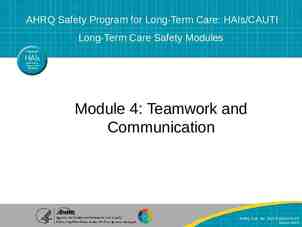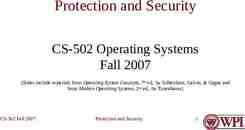The eight components of implementing strategy Allocation Resources
32 Slides200.79 KB

The eight components of implementing strategy Allocation Resources Establishing StrategySupportive Policies Building a Capable Organization Exercising strategic Leadership Shaping Corporate Culture to Fit Strategy Strategy Implementer’s Action Agenda Tying rewards to achievement of key strategic targets Instituting Best Practices for Continuous Improvement Installing Support Systems to Carry out Strategic Roles 1

Building a capable organization Select able people for key positions Develop skills, core competencies, managerial talents, competitive capabilities Organize business processes, value chain activities, and decision-making to promote successful strategy execution 2

Strategy and organization structure Few hard and fast rules for organizing Main Rule: Structure must support and facilitate good strategy execution Each firm’s organization structure is idiosyncratic, reflecting Prior arrangements, internal politics Executive judgments and preferences about how to arrange reporting relationships 3

Matching organization structure to strategy: the steps to take 1. Pinpoint critical activities and capabilities 2. Decide which activities to outsource 3. Decide which activities require “Partners” 4. Make primary, internally-performed activities the main building blocks 5. Determine degree of authority to delegate 6. Establish ways to achieve coordination 7. Assign responsibility for managing relationships with outsiders 4

Uniting efforts of interrelated organizational units: the options Coordinating teams Cross-functional task forces Dual reporting relationships Informal networking Incentive compensation tied to group performance Teamwork and interdepartmental cooperation 5

Why structure follows strategy Changes in strategy typically require a new structure for implementation to be successful Research indicates Structure affects performance Structure merits reassessment whenever strategy changes New strategy involves different skills and key activities How work is structure is a means to an end-not an end in itself! 6

Strategy and Structure: Evolutionary Pattern Simple Structure Efficient Implementation of Strategy Sales Growth Integration & Control Problem Functional Structure Organization form in which the owner-manager take all decisions and monitors all activities, while staff aids in monitoring & supervising Less Specialization No Communication Barriers Quick Decisions (e.g. Restaurants, Retail Shops) CEO and functional line managers in dominant areas like production, marketing, HR, finance etc. 7

Strategy and Structure: Evolutionary Pattern CEO and functional line managers in dominant areas like production, marketing, HR, Finance etc. Sales Growth Integration Problems Multi Divisional Structure * Efficient Implementation of formulated strategy Excessive diversification and complexity calls for this design Operation Divisions each a separate SBU and top officer delegates unit strategy to divisional managers. Organization structures are modified when they no longer “ENABLE COORDINATION & CONTROL” Managers require for implementing newly designed strategy Impose STRATEGIC and FINANCIAL controls and evaluate performance 8

When do traditional hierarchical structures make strategic sense? When activities can be divided into simple, repeatable tasks and are efficiently performed in mass quantity There are important benefits to deep functional expertise Customer needs are standardized 9

When are multi-layered authoritarian structures liability? Market conditions are fluid Customer preferences shift from standardized to customized products and features Personalized customer service is essential Product life-cycles grow shorter Flexible manufacturing replaces mass production Customers want to be treated as individuals Pace of technological change accelerates 10

Organizational structures of the future: success depends on Quick response to shifting customer preferences short design – to – market cycles First-time quality Custom order and multi-version production Expedited delivery and accurate order filling Personalized customer service Rapid assimilation of new technologies Creativity and innovativeness Speedy reaction to competitive developments 11

Organizational structures of the future: meeting the new requirements Decentralized structures with fewer managers Small-scale business units Reengineering to decrease fragmentation Development of stronger and newer capabilities Collaborative partnerships with outsiders Empowerment and self-directed work teams Lean staffing of corporate support functions Open communications (e-mail, IS, etc) Accountability for results 12

Characteristics of organizations of the future Fewer boundaries between Different vertical ranks Functions and disciplines Units in different geographic locations Firm and its suppliers, distributors, strategic allies, and customers Capacity for change and learning Collaborative efforts among people in different functions and geographic locations 13

MINTZBERG Strategic apex Ide Middle line Support staff gy olo Technostructure Operating core 14

Functional Structure: Implementing Business Level Strategy 1. COST LEADERSHIP PRESIDENT CORPORATE STAFF ENGINEERING MARKETING OPERATIONS PERSONNEL 15

Specialization, centralization play a pivotal role in implementation of cost leadership strategy 1. SPECIALIZATION Divide work into homogenous groups. Cost reduction through efficiency achieved By employee specialization in few activities 2. CENTRALIZATION Decision making authority at managerial level. However, managers strive to push down some decision making authority lover 3. FORMALIZATION Rules and procedures govern activities foster efficient operations, R & D improvements and mass scale production of standardized goods 16

2. DIFFERENTIATED STRATEGY PRESIDENT & CORPORATE STAFF R&D NEW PRODUCT R&D OPERATIONS MARKETING MARKETING HR FINANCE 17

Decision making authority is decentralized Coordinate and integrate activities Concensus style of decision making Marketing and R & D functions More Focus Product innovations (L’OREAL) Flat structure, more flexible, and jobs less structures Constantly seeking improvement in product design, image, quality Creative Advertising 18

3. THE INTEGRATED APPROACH: Provide value which differs from that offered by rival firms Low Cost Valuable Differentiated features For cost leadership focus in on process recast and operational excellence (Standardised product) For differentiation in features emphasis is on marketing, innovation & new product development Therefore, functional form has to be supplemented by cross function a teams and strong culture. (e.g. TOYATA MOTORS – Differentiated production & Design process) 19

4. SHIFT TO MULTIDIVISIONAL DESIGN: The above average profits through successful implementation of business level strategy results in diversification of the firm’s operations Product portfolio diversification Market diversification Corporate level strategy business level strategy for each SBU 20

ORGANISATION STRUCTURE: Corporate Level Strategy THREE VARIETIES OF MULIDIVISIONAL STRUCTURE Multi Divisional Structure (M-Form) CO OPERATIVE FORM SBU FORM COMPETITIV E FORM 21

COOPERATIVE Related constrained strategy HR practices to foster cooperation Integration of firms divisions SBU FORM Related linked strategy Each SBU has corporate leader, SBU groups and divisions grouped by relatedness SBU Individual decision makers seek guidance from SBU heads COMPETITIVE FORM Unrelated Diversification Strategy Competition between business units Allocation of capital based on performance 22

COOPERATIVE DESIGN CORP. HQ. GOVT. CORPORATE R&D PRODUCT DIVISION LEGAL AFFAIRS STRATEGIC PLANNING PRODUCT DIVION CORPORATE HR CORPORATE MARKETING PRODUCT DIVISION CORPORATE FINANCE PRODUCT DIVIONS Tight links across all divisions and strong relationship Centralization at corporate office to foster co-operation between divisions Cooperative sharing Rewards are governed by divisional and corporate performance 23

SBU DESIGN CORP. HQ. PRESIDENT CORPORATE R&D CORPORATE FINANCE SBU 1 Division Div 2 STRATEGIC PLANNING CORPORATE MARKETING SBU 2 Div 3 Div 1 Div 2 CORPORATE HR SBU 3 Div 3 Div 1 Div 2 Integration among divisions within SBUs, but independence across SBUs Each SBU-own budget & staff to foster integration Corporate planning most prominent for managing approval process Corporate HQ staff advise SBUs and Divisions Div 3 24

COMPETING DESIGN CORP. HQ. PRESIDENT LEGAL AFFAIRS DIVISION FINANCE DIVISION DIVISION AUDITING DIVISION DIVISION Corporate HQ Lean and competent Finance and Auditing Prominent Functions to Manage cash flows and disclose performance information Divisions are independent Retain corporate control The legal affairs function most prominent - Acquisition or Divestiture Compete for corporate resources 25

ORGANIZATIO STRUCTURE: Implementing International Strategies 1. MULIDOMESTIC STRATEGY Strategic and operating decisions are decentralized t business units in each country No need for integration or coordination A structure concentrating on national interests to satisfy local & cultural mismatches 2. GLOBAL STRATEGY Decision making authority is centralized Need to coordinate and integrate operations Superior communication systems and quick decisions 3. TRANSNATIONAL STRATEGY Combination of global efficiency and local responsiveness Geographic and product structure Incredibly difficult to accomplish Cultural change must be effective to foster leadership and a shared vision 26

PRODUCT DIVISIONAL STRUCTURE: GLOBAL STRATEGY Worldwide Products Division Worldwide Products Division Worldwide Products Division GLOBAL CORP HQ Worldwide Products Division Centralize to coordinate information flow among worldwide products Facilitate global economies of scale & Scope Allocate financial resources in a cooperative manner Centralized federation COST LEADERSHIP ADVANTAGE 27

USA ASIA MIDDLE EAST/ GULF MULTINATIONAL HQ EUROPE WORLDWIDE GEOGRAPHICAL AREA STRUCTURE: MULTIDOMESTIC STRATEGY LATIN AMERICA Decentralization of operations Emphasis and attention on local needs to match country culture Decentralized federation Corporate HQ Coordinates resources among independent subsidiaries 28

Structural Types for Multinationals (1) International Divisions Usually dominant home base With its own structure And additional international division Drawing on products or services of home division 29

Structural Types for Multinationals (2) International Subsidiaries Independent operations by country Allowing for high local responsiveness Perhaps with central planning or reporting But now ultimate central control 30

Structural Types for Multinationals (3) Global Businesses Product/ service divisions managed globally Aim is to produce scale efficiencies And transfer of resources/ skills Requires sophisticated co-ordination May reduce sensitivity to local markets 31

Increasing Devolution - Some common problems Concept not understood Centre cannot let go Centre lets go too much Self-sufficiency vs. bargaining Enabling framework vs. regulations Fear of accountability 32






